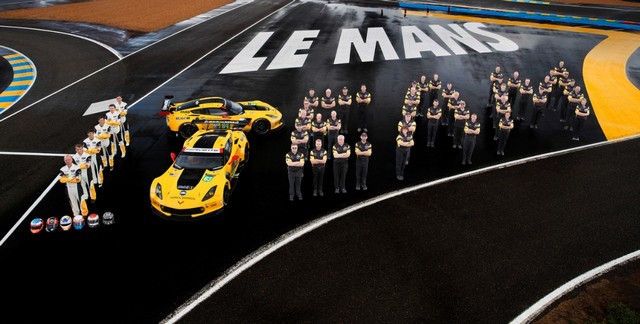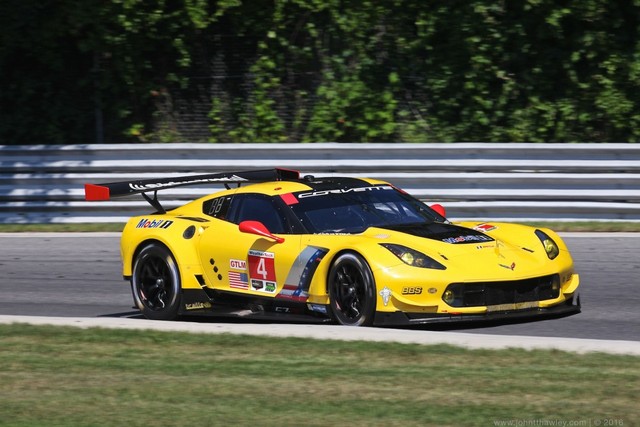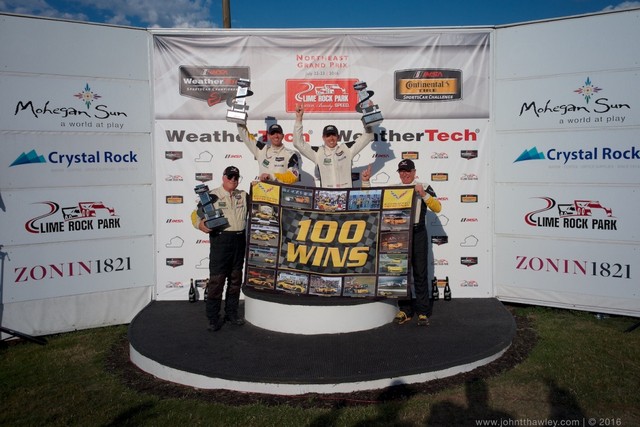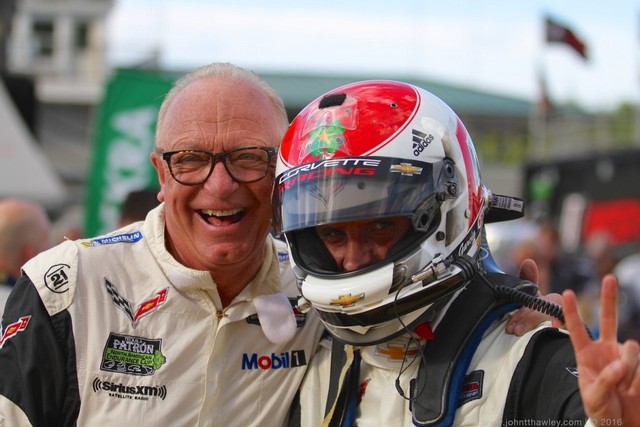Editor-In-Chief's Note: This week, the IMSA WeatherTech SportsCar Championship returns to its spiritual home, Road America - "America's National Park of Speed" - in Elkhart Lake, Wisconsin. The spectacular, 4.048-mile, natural-terrain road racing circuit carved out of the beautiful Kettle Moraine country is America's ultimate road racing facility and the track that showcases sports car racing at its best. A couple of years ago I suggested that Jim France's - also the ALMS' "M.O." before him - cozy relationship with the ACO would eventually backfire on IMSA and of course, it did. I talked about this very subject in a recent column, "GTX: The Idea That Just Might Save IMSA" while providing a solution to the turbulent waters that seem to constantly roil sports car racing in this country. I received excellent feedback on that column, and even though the usual naysayers came out of the woodwork, manufacturer representatives got word back to me expressing serious interest in the idea. I will tell you one thing with certainty, road racing in this country needs - and deserves - bold moves. For the powers that be at IMSA to go along pretending everything is okay while doing the same things over and over again - the sanctioning body will reveal its 2017 schedule this weekend - is a nonstarter and a recipe for disaster. Major league sports car racing in this country needs to carve out its own identity to survive. Just going along to get along, which seems to be the current operating principle, is simply not going to cut it. I will have a new "Fumes" column up next week, but we thought that leaving the tribute to Corvette Racing up was appropriate, given the magnitude of the team's achievement. -PMD
By Peter M. De Lorenzo
Detroit. When Oliver Gavin crossed the finish line in Saturday’s IMSA WeatherTech SportsCar Championship Northeast Grand Prix at Lime Rock Park in his Pratt & Miller-prepared No. 4 Corvette Racing C7.R, he not only won the GT Le Mans class, he and co-driver Tommy Milner gave Corvette Racing its 100th sports car racing victory. It was the third win of the season for the duo and the first since back-to-back GTLM class victories at Daytona and Sebring. And with Antonio Garcia and Jan Magnussen (No. 3 Chevrolet Corvette C7.R) finishing second in the Corvette Racing team car, they delivered the team's 60th 1-2 finish in major league sports car racing.
To say that this is an incredible achievement doesn't do the program justice, however, because the overall excellence that has marked this program from the beginning is a testament to a will to win against all odds and a focused consistency over sixteen years of competition that has secured Corvette Racing's legacy as one of the great teams in history.
First, in order to better understand Corvette Racing's accomplishments, a primer is in order. Anyone who has read this column over the years has been privy to an insider's view of the machinations and political gamesmanship that go on in corporate racing programs. Major expenditures on racing by the car companies used to be a simpler decision, especially if the executives at the top of the company liked racing and wanted to be involved. The most famous example being when Henry Ford II, peeved at Enzo Ferrari's last-minute refusal to be acquired by Ford after months of negotiations, vowed to kick Ferrari's ass on the race track, punctuating his orders with, "I don't care what it costs."
Now? Racing at the corporate level is dominated by Return On Investment (ROI), as in it has to be tied to major engineering and marketing programs, or, as the German car companies have demonstrated so successfully, preferably both. One could argue that a racing program is better off with an ROI focus, because then it isn't subject to negative political winds generated by a few executives who perpetually don't get it. But still, when all factors are tallied, there has to be a fundamental willingness to compete and win at the very top levels of the company in order for a racing program to achieve success.
Needless to say that hasn't always been the case at General Motors. Make no mistake, for the True Believers within Engineering, Design and Product Development, the fire has burned white hot from the very beginning, but there was always something or someone plotting to derail things or getting in the way. There was the infamous - and silly - ban on racing in the late 50s that the AMA arm-twisted the American manufacturers to abide by, which the execs at the top of GM at the time adhered to with a blind fealty that still makes me wince. The tone and tempo set into motion by adhering to that ban was directly responsible in preventing GM from openly competing at the highest levels of racing. It killed Zora Arkus-Duntov's Corvette Grand Sport program, for instance, and it then forced GM's True Believers to go underground, for a long, long time. This was in juxtaposition to Ford, which was forging a go-go attitude with its "Total Performance" corporate marketing program that dominated the 60s and that was marked by a series of high-performance street cars and by competing in every major league racing series at the time.
But against all odds, the True Believers at GM achieved incredible success with their clandestine, "backdoor" racing support programs. Their direct involvement in helping Jim Hall with his advanced Chaparral racers - even going so far as having their own test Chaparral racer "test" vehicles hidden away at Chevy Engineering - was just unbelievable when you go back and understand what they achieved. GM's developments in advanced metals, including aluminum engine blocks, innovative composites and groundbreaking aerodynamics alone are legendary to this day, including the advanced ground effects concept of the Chaparral 2J, which originated within Chevrolet Engineering. So while Ford was competing openly, GM's True Believers had to do it in roundabout fashion, supplying engines, parts and technical assistance to a long list of legendary racers in Can-Am, Trans-Am, NASCAR, SCCA (including my brother Tony, who along with Jerry Thompson put Corvette back on the racing map with the famed Owens Corning Corvette Racing Team), IMSA and NHRA racing, and with much success too. (You can read the definitive story about GM's True Believers and their excellent adventures in "backdoor" racing from 1957 through 1970 in Paul Van Valkenburgh's superb book Chevrolet - Racing? 14 Years of Raucous Silence, which has been recently reprinted.)
Throughout GM's history, racing programs have been subject to the vagaries, whims and wishes of executives who either didn't get racing, or were flat-out dead set against it. It seems that the True Believers within Engineering, Design and Product Development at GM were always going against the wind, having to be "rescued" by a series of enthusiast executives who had their backs and helped fuel and support their passion along the way. Fortunately, even in GM's case nothing bad could last forever, and the company's racing endeavors finally became more open and more demonstrative, especially in NASCAR and Indy cars.
What does this back story have to do with Corvette Racing today? Well, it has everything to do with the Corvette Racing story.
Let's pick up the story of the modern Corvette Racing team before it was born, when it began way back in 1996 as a interesting idea to promote the new C5 Corvette and add to its performance credibility through racing, and see how it all came together. And who better to help tell the story than none other than Doug Fehan, the Corvette Racing Program Manager who was there at the very beginning.
I asked Doug in an email interview what his recollections were of how the Corvette Racing program got started: "It was in late summer of 1996. Herb Fishel, then Director of GM Racing, brought me into his office and asked me to dust-off an old Corvette Racing proposal I had made back in 1992. He wanted it tweaked and massaged to represent a totally new program befitting the fifth-generation Corvette C5, which was going to make its debut at the Detroit International Auto Show in January 1997. We worked together to get it in close parallel with the new corporate goals and objectives. I made that presentation to the Chevrolet General Manager, John Middlebrook, and the rest of the entire Corvette team in the fall of 1996. We got it approved in the meeting and immediately began implementing the design and build of the first C5.R race car."
One of the most memorable times for the Corvette racing program was when Dale Earnhardt and Dale Earnhardt Jr. drove for the team at Daytona in the 24 Hours in 2001. I asked Doug to comment on that: "I have so many great memories of the time I got to spend with Dale and Dale Jr. It all remains so vivid in my mind it is like it took place last season. I think the thing that stood out most about Dale Sr. was his abject humility. He wanted to be treated exactly like every other team member, do what every team member was required to do, attend every meeting and take part in every event. He was very serious about becoming a member of our team. He was an amazing and inspirational guy. I am not sure I ever go to a race and not think of him. I consider myself very fortunate to have known him for the short time I did."
One of the most enduring parts of Corvette Racing's success has been its wins at the 24 Hours of Le Mans, where the team has recorded eight victories in the top GT class in sixteen years. I asked Doug what it was like going to Le Mans the first time, as opposed to now. "Our first trip to Le Mans is really kind of a blur. We were immersed into such an intimidating world. A foreign country, different language, different food and racing against the best in the world. We all leaned heavily on each other just to find a way through. It seemed like everything we had planned on doing met with adversity but, we plodded and pushed and never gave up. We made the podium, finishing third, which was actually pretty damn amazing and it just fueled us to go back and get better. We knew we could improve. We knew we could compete with the best teams in the world. And we wanted to win. Today when we go, we are actually the benchmark for each and every GT team. Having won the thing eight times earns you a lot of respect. But we remain humble, keep our shoulders to the wheel and focus on what we are doing… not what the other guy is doing. The team is incredibly organized and we hit the ground running every year. It’s a lot of work but, it is a ton of fun and remains the focus of our program."
After 100 wins there have to be many indelible memories for the team, I asked Doug for a few of his. "Well, having just won our 100th race together I have a lot from which to choose! Obviously, our very first victory in Texas comes to mind. It was an incredible 117 degrees at 7 p.m. for the race, and Ron Fellows had gotten out after his stint very overheated, and I remember taking a garden hose and spraying him down in the paddock area while he sat in a lawn chair in his tighty-whities. Andy Pilgrim brought home the victory actually lapping the second place Viper. You don’t forget something like that."
And there was the time the team won the Daytona 24 Hour race overall in 2001. "The overall win at the 2001 Daytona was definitely an amazing experience," Fehan commented. "In those days, they kept the winning car and parked it in the lobby of the museum. The following morning, on my way to the airport, I stopped to look in the window to see our car sitting there with the winner’s trophy placed proudly on the roof. As my face was pressed against the glass, the security guard in the building recognized me and asked if I would like to come in. I did and I sat there for almost an hour in the dim morning light, looking at that great battle-worn race car, reflecting on what the team had accomplished, with tears welling in my eyes. I still get emotional thinking about those moments."
A proper memory of the scope of Corvette Racing's success has to include the 24 Hours of Le Mans. Doug had this to say: "Of course, in the top three has to be our first Le Mans victory in that same year, 2001. It rained for most of the race and there was lots of crashing and carnage… but, we survived. I recall we had about a four-hour lead over the next closest competitor. There was no sense in running all four of those last hours and risking something bad happening. So, I checked with officials to see if it was permitted to simply park the cars for a few hours and send them out at the finish. They assured me it would be fine, and smart, to do just that. We brought both of them in, did some routine maintenance, cleaned them up, and ran that last hour very, very carefully. In the end, every one of us was totally exhausted and overcome with emotion… lots of hugging… and not a dry eye among the entire team. It simply was one of those unforgettable experiences that will never fade."
Karl Ludvigsen, a PR man who once worked for my father and who became a famous - and gifted - author, journalist and historian, wrote the definitive tome about Porsche (among many other books), entitled Porsche: Excellence Was Expected.
I am going to borrow Karl's title - with all due respect - because it applies to Corvette Racing as well. This team sprung from the doldrums of a company that had forgotten all about the competition heritage of its very own sports car, the Corvette, and with that one fateful decision back in the fall of 1996 decided to not only honor the machine's rich historical legacy, but endeavored to write new chapters on the race tracks of the world with a full-on factory racing effort for the very first time.
And in doing so Corvette Racing has forged a level of excellence and achievement that will endure the test of time. And the icing on the cake? Corvette Racing has accomplished all of this while playing a definitive role in the constant, accelerated development and improvement to the performance of Corvettes that are available for enthusiasts to drive on the street, in an ultimate example of the efficacy of a focused ROI.
Over the years it has been a constant battle within GM to use and promote the success of Corvette Racing. In too many instances the team's achievements have been underused, or ignored all together. And it's really a shame because Corvette Racing projects a level of excellence and success that should be cherished and used frequently by GM and GM marketing, because it represents the tip of GM's technological spear and the impressive capabilities of the company's best and brightest.
For the True Believers within GM, Corvette Racing is a source of pride - and excellence - that never gets old. As it should be.
I can't possibly mention everyone who has made contributions to the program over the years, but you know who you are and I hope you have big smiles on your faces right now. But I can mention a few people today. I'll start with Gary Pratt and Jim Miller, the two leaders of Pratt & Miller Engineering, the talented organization that has cut its own wide swath of excellence in the racing world and beyond and prepares the Corvette C7.Rs for competition. And Doug Fehan, the Corvette Racing Program Manager who has been there from the very early days.
Then there's Doug Louth, Director of Engineering for Pratt & Miller. Dan Binks, the Crew Chief for the No. 3 Corvette and Kyle Millay, chief engineer on the No. 3 machine. And Brian Hoy, Crew Chief for the No. 4 Corvette and Chuck Houghton, chief engineer on the No. 4 machine.
And of course, Mark Kent, Director of all of GM Racing's programs; and last but not least, Jim Campbell, Vice President of Performance Vehicles and Motorsports.
And I can't close this column without mentioning GM's True Believer-in-Chief, Mark Reuss, Executive Vice President of Global Product Development and Global Purchasing & Supply Chain, who can often be found embedded in Corvette Racing's pit box with a headset on.
I would like to extend my heartfelt congratulations to the entire Corvette Racing Team family and to the key players at GM who support the program unfailingly with everything they have.
Excellence expected. Excellence Delivered.
And that's the High-Octane Truth for this week.

(Photo by Richard Prince for GM/Chevrolet Racing)
The No. 63 Konica Minolta/Mobil 1/Sirius-XM Chevrolet Corvette C7.R and drivers Antonio Garcia, Jan Magnussen and Ricky Taylor; and the No. 64 Konica Minolta/Mobil 1/Sirius-XM Chevrolet Corvette C7.R and drivers Oliver Gavin, Tommy Milner and Jordan Taylor pose for a group photo with the entire Corvette Racing team the week before the 24 Hours of Le Mans at Circuit de la Sarthe in Le Mans, France, last month.

(John Thawley ~ Motorsports Photography @ www.johnthawley.com ~ 248.227.0110)
Tommy Milner and Oliver Gavin (No. 4 Chevrolet Corvette C7.R) gave Corvette Racing its 100th sports car racing victory and led the team’s 60th 1-2 sweep in Saturday’s IMSA WeatherTech SportsCar Championship Northeast Grand Prix at Lime Rock Park.

(John Thawley ~ Motorsports Photography @ www.johnthawley.com ~ 248.227.0110)
Gary Pratt (Pratt & Miller Engineering), Oliver Gavin, Tommy Milner and Doug Fehan (Program Manager, Corvette Racing) celebrate after Corvette Racing's 100th sports car racing victory at Lime Rock.

(John Thawley ~ Motorsports Photography @ www.johnthawley.com ~ 248.227.0110)
Doug Fehan with Antonio Garcia after Corvette Racing's big win at Lime Rock.
Editor's Note: Many of you have seen Peter's references over the years to the Hydrogen Electric Racing Federation (HERF), which he launched in 2007. For those of you who weren't following AE at the time, you can read two of HERF's press releases here and here. And for even more details (including a link to Peter's announcement speech), check out the HERF entry on Wikipedia here. -WG
Publisher's Note: As part of our continuing series celebrating the "Glory Days" of racing, we're proud to present another noteworthy image from the Ford Racing Archives. - PMD

(Photo by Dave Friedman, courtesy of the Ford Racing Archives)
Riverside, California, January 17, 1965. The great Junior Johnson wheels his No. 27 Holly Farms Poultry Ford during that year's "Motor Trend 500" NASCAR Grand National race at Riverside International Raceway. Johnson qualified on the pole but finished second to Dan Gurney (No. 121 Wood Brothers Augusta Motor Sales Ford). Marvin Panch (No. 21 Wood Brothers Augusta Motor Sales Ford) finished third. A.J. Foyt (No. 00 Holman-Moody Vel's Ford) survived one of the worst wrecks of his career during this event. The race took an incredible five hours and 41 minutes to run (racing-reference.info). Watch a video here.
Publisher's Note: Like these Ford racing photos? Check out www.fordimages.com. Be forewarned, however, because you won't be able to go there and not order something. - PMD